Tsunami tragedy 2004
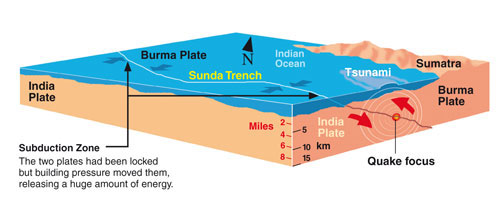
Countries surrounding the Indian Ocean experienced widespread devastation on 26 December 2004, following an earthquake off the West Coast of Northern Sumatra.
Striking at 7:58 am local time, the earthquake was caused by a massive slip between two of the rigid plates that make up the crust of the earth (see diagram above). With a magnitude of 9.3 on the Richter scale1, vertical movement between the Indian and Burmese plates was about 13 m (43 ft) over an incredible 1,200-km (750-mile) rupture length.

Like a giant underwater paddle, the movement of the ocean floor created a tsunami2 that spread in all directions. In the open ocean a tsunami generally goes unnoticed [wrong! - J.Ch.], even though it travels as fast as a jumbo jet. But when it reaches shallower water, it slows down and increases greatly in height.
Estimates are conflicting, but the death toll from the disaster was about 300,000 people, with tens of thousands missing and over a million left homeless. In terms of lives lost, this would be the worst single tsunami in modern history. The previous worst was the 1703 tsunami at Awa, Japan, that killed over 100,000 people.
In Banda Aceh, the city closest to the epicentre, the tsunami arrived about 20 minutes after the earthquake was felt.3 The shaking was severe, with residents reporting being unable to walk or even squat without being knocked to the ground. Many buildings withstood the earthquake but were destroyed by the tsunami waves.

In Sri Lanka, 1,600 km away, the first wave began to impact the eastern coast about 100 minutes later. A secondary wave struck approximately 20 minutes after that.
Scientific reports will continue to be published on what will be one of the most devastating earthquakes this century.
Unprecedented disaster?
Louis Michel, European Commissioner for Development and Humanitarian Aid, called the tsunami ‘an unprecedented disaster both in terms of human suffering and the physical damage wrought’.4

It was certainly the largest watery disaster in recent history, but was it unprecedented? No. A catastrophe some 4,500 years ago inundated more of the globe, killed more people, destroyed more homes and left a greater trail of geologic evidence. Only eight people on the entire planet survived that disaster—Noah and his family—together with a collection of animals and birds [fairy tales and myths! - J.Ch]. The 2004 tsunami gives a tiny insight into the magnitude of the largest physical disaster in earth history.
The earthquake that triggered the tsunami was just one quake, albeit with a magnitude of 9.3. At any location on the coast it took only a couple of hours for the water to rush in and flow back to sea. But after the water was gone, the devastation was horrific. Some parts of the coastline were radically uplifted, some stayed submerged and others were washed away.
No comparison
Compare this with the disaster documented in the Bible. Noah’s Flood would have begun with massive earthquakes when the fountains of the great deep burst open (Genesis 7:11). But Noah’s Flood also involved heavy rain (Genesis 7:12) and a continual increase in sea-level (Genesis 7:17–20). The disaster was not over in an hour or two, but continued to worsen day after day for five whole months (Genesis 7:24).

Imagine the situation in the countries around the Indian Ocean if a second tsunami had followed the first a couple of hours later. Then a third two hours after that. And so on. How would the people respond when they realized that the hills on which they were sheltering were slowly disappearing into the sea? Imagine the panic as each new wave eroded the land away in huge chunks. Visualise this continuing into the night, and then the whole of the next day, and then the next, for five months.
There would have been no chance to mount an international rescue effort. The focus on the ground would have moved, from helping the victims, to escaping the ongoing calamity. Whole communities would have moved to higher ground at first. Then what? There would be no time to build rafts or boats, and nowhere to get food or water for six months on the open sea.
The tsunami of 2004 should make us question those who claim that Noah’s Flood never could have happened. Considering that our planet is two-thirds covered with water, 11 km (7 miles) deep in places, the tsunami demonstrates how a relatively small disturbance to the earth’s crust will inundate vast areas within hours. How much more devastation would have been caused by Noah’s Flood, which involved far more than a single tsunami wave?

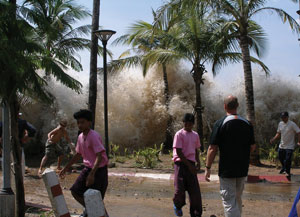
A wall of water
Onlookers are taken by surprise as the tsunami breaks across the beach with awesome fury. With a death toll in the hundreds of thousands, cities and towns around the Indian Ocean were destroyed or severely damaged by the results of this single event.
The later flooding effects of Hurricane Katrina in the USA once again gave a stark and deadly reminder of the awesome power and destructive force of large volumes of water.
Noah’s Flood inundated the entire earth, leaving its mark in the world’s geology with sediments up to many kilometres thick. The remains of billions of dead creatures buried in rock layers laid down by water all over the world testify to this cataclysm.
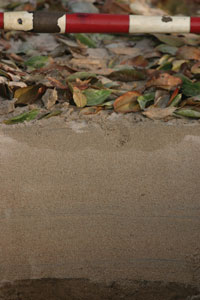
Sediments and eyewitness
People today try to dismiss the Bible’s history of the world because they believe the rock layers are a more reliable testimony. However, rocks cannot talk about the past. People speak for them.
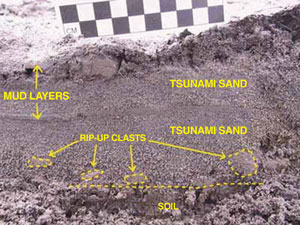
Is the tsunami relevant to how geologists talk about rock layers? Yes, because the tsunami had eyewitnesses. That is why, in January 2005, teams of scientists visited the devastated areas to document its geological effects.1,2They call it ‘ground truthing’.
At Nalaveli Hotel in Sri Lanka, they found 20 cm (8 inches) of sand deposited in two beds on soil, consistent with eyewitness reports of two waves. The contact between the beds is identified by a darker mineral layer. In each layer the sand grades upward from coarse to fine—a graded bed.
Graded beds are typical of a wave deposit. Sometimes marine animals are scattered on the surface. The lowest bed often contains rip-up clasts3 (pieces of the underlying material ripped up by the wave).
Clearly, the bed of sediment does not represent a living environment. The tsunami collected the sediment, marine animals and other material from a number of environments and deposited them together.The lighter material, such as branches, bark and wood, was deposited elsewhere. If a scientist examined the fossils in the beds of sediment and said they showed how life evolved over a long period of time he would be wrong.
References and notes
- The 26 December 2004 Indian Ocean tsunami: initial findings from Sumatra: based on survey conducted January 20–29, 2005, Sumatra international survey team, USGS (US Geological Survey), walrus.wr.usgs.gov/tsunami/sumatra05. Return to text.
- The 26 December 2004 Indian Ocean tsunami: initial findings on tsunami sand deposits, damage and inundation in Sri Lanka : based on survey conducted January 9–15, 2005, walrus.wr.usgs.gov/tsunami/srilanka05. Return to text.
- Preliminary analysis of sedimentary deposits from the June 23, 2001 Peru tsunami, walrus.wr.usgs.gov/peru2/index.html. Return to text.
Survived at sea
The receding waters of the tsunami dragged people out to sea, including Malawati, a 23-year-old Indonesian woman. She survived for five days, badly sunburnt and bitten by fish, by clinging to a sago palm and eating its fruit and bark. She saw sharks all around but, incredibly, none attacked her.
Rizal Shahputra, a 23-year-old Indonesian from Banda Aceh drifted in the open ocean for eight days. Along with scores of other people, he clung to floating planks of wood. Dead bodies were all around. One-by-one everyone but Rizal was swallowed by the sea, including his family members.
The container vessel MV Durban Bridge rescued him 160 km (100 miles) west of Aceh. Emerging sunburnt and weak from a floating raft of trees and branches, Rizal had survived on rainwater and coconuts.
To stay alive at sea for eight days is exceptional. But, without anyone to rescue them, the people in Noah’s day, people who managed to cling to floating vegetation would have perished of exposure and starvation in the months that followed. Their remains would never have been found.
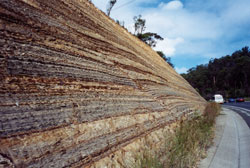
Warnings went unheeded
Waverly Person of the USGS National Earthquake Information Center said that many people could have been saved if the countries most severely affected—including Indonesia, Sri Lanka, Thailand and India—had had a tsunami warning system, or even tide gauges.1
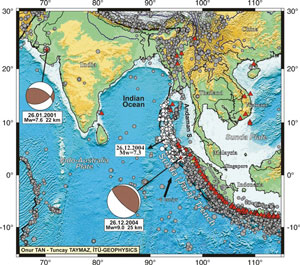
A tsunami is generated at the source of the underwater earthquake and so, depending on locality, there is usually 20 minutes to two hours for people to move to higher ground. Because tsunamis are extremely rare in the Indian Ocean, people had not been taught to escape disaster by fleeing inland after they felt the tremors of an earthquake.
Victor Desosa, a former merchant seaman who had experienced a tsunami in Chile, saved the village of Galbokka in Sri Lanka . When the water receded (just before the tsunami arrived) he ran around telling his neighbours to run for it. They believed him and as a result, only one of several hundred inhabitants of his village was killed. Casualty rates in nearby villages were 70% to 90%.2
This also reminds us of the days of Noah. Because a global flood had never occurred before, people did not believe it would happen. Only Noah heeded the warning and only his family was saved. The Bible anticipates that people will deliberately forget that Noah’s Flood ever took place, and therefore will be unprepared for the future final global destruction by fire coming on the earth (2 Peter 3:3–7).
References and notes
- USGS: warnings could have saved thousands in Asia—26 December 2004, iri.columbia.edu/~lareef/tsunami.
- 2004 Sumatra earthquake and Indian Ocean tsunami, EERI power point presentation, www.eeri.org/cds_publications/catalog.
The power of water
During the worldwide Flood of Noah’s time, massive movements in the earth’s crust would have caused huge tsunamis and destruction on a global scale. The Indonesian quakes and resulting waves would have been tiny by comparison to the events at the time of the great Flood. Billions of creatures, including dinosaurs, were killed and buried in sediments as the entire earth became flooded. Fossils frequently show creatures suddenly killed and buried.

Related Articles
Further Reading
References and notes
- Early estimates were magnitude 9.0 but later analysis including longer-wavelength seismograms showed it was three times larger. See; Sieh, K., Aceh—Andaman earthquake: What happened and what’s next? Nature434(7033):573–574, 2005; Richter magnitude is a logarithmic scale, so an earthquake of magnitude 9.0 has 10 times the displacement but over 30 times the energy of one of magnitude 8.0. Return to text.
- Tsunami is Japanese for harbour wave. Return to text.
- The great Sumatra earthquake and Indian Ocean tsunami of December 26, 2004, EERI (Earthquake Engineering Research Institute), May 2005, www.eeri.org/lfe/pdf/india_srilanka_tsunami_eeri_socsci_report.pdf. Return to text.
- Press conference by Louis Michel, European Commissioner for Development and Humanitarian Aid, 31 December 2004, europa.eu.int/comm/echo/whatsnew/statement_press_31-12-2004_en.htm. Return to text.



Keine Kommentare:
Kommentar veröffentlichen